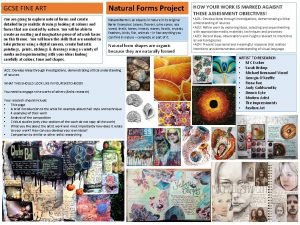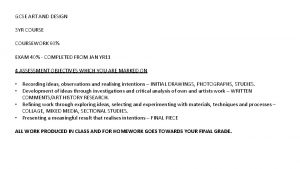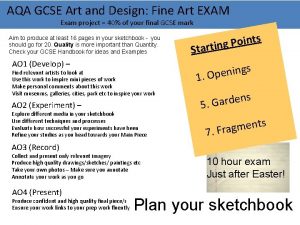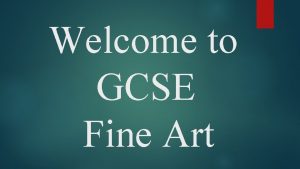GCSE FINE ART Natural Forms Project You are



- Slides: 3

GCSE FINE ART Natural Forms Project You are going to explore natural forms and create detailed large realistic drawings looking at colours and forms that are created by nature. You will be able to create an exciting and imaginative piece of artwork bases on this theme. You will learn the skills that are needed to take pictures using a digital camera, create fantastic paintings, prints, etchings & drawings using a variety of media and experimenting with your ideas looking carefully at colour, tone and shapes. Natural form is an objects in nature in its original form. Examples: Leaves, flowers, pine cones, sea weed, shells, bones, insects, stones, fossils, crystals, feathers, birds, fish, animals – in fact anything you can find in nature – complete or part of it. Natural form shapes are organic because they are naturally formed AO 1: Develop ideas through investigations, demonstrating critical understanding of sources. WHAT THIS SHOULD LOOK LIKE IN YOUR SKETCHBOOK You need to engage n the works of others (Artist research) Your research should include: • Title page • A brief introduction to the artist for example about their style and technique • 4 examples of their work • Analysis of the composition • Critical studies (only view sections of the work do not copy all the work) • What you like about the artist work and most importantly how does it relate to your work? How can you develop your own ideas? • Comparison to similar or other artist researching HOW YOUR WORK IS MARKED AGAISNT THESE ASSESSMENT OBJECTIVES! • AO 1: Develop ideas through investigations, demonstrating critical understanding of sources. • AO 2: Refine work by exploring ideas, selecting and experimenting with appropriate media, materials, techniques and processes. • AO 3: Record ideas, observations and insights relevant to intentions as work progresses. • AO 4: Present a personal and meaningful response that realises intentions and demonstrates understanding of visual language. ARTIST TO RESEARCH • M C Escher • Sarah Bishop • Michael Brennand Wood • Georgia O’Keeffe • Fiona Rae • Andy Goldsworthy • Dennis Kyte • Modern Artist • The Impressionists • Realism Art

AO 2: Refine work by exploring ideas, selecting and experimenting with appropriate media, materials, techniques and processes. Experiment with colour and materials WHAT THIS SHOULD LOOK LIKE IN YOUR SKETCHBOOK Vary the size of drawings You need to explore and experiment with material and ideas How to show this in your sketchbook • Refine a dominant ideas by trying different compositions • Use different materials • Don’t keep drawing the same content using different material develop the idea, refer to your theme and research • Clearly demonstrate purposeful use of material, refer to your theme and artist research and annotate your work, why and What you have done? • Don’t copy your artist work use their idea behind their work • Be selective and annotate constraints and success, what did and did not work WHAT REFINE & RECORD MIGHT LOOK LIKE The same image is reoccurring in different compositions. Either information is reduced or added to with other elements. Don’t go mad with annotating, make it relevant and straight to the point, why and how it relates to your theme and artist? And what you intend to do next? It’s a good to add in any artist research on the same page just to reference where you idea might stem from. Objects and materials that communicate your idea is great to add in, these are still classed as observations Observations can be photographs Engraving and drawing on to different textures is a good way to show technique and variation AO 3: Record ideas, observations and insights relevant to intentions as work progresses. You need to show your idea develops, Writing, Drawing , Photographs, screen shots of digital developments & annotations WHAT THIS SHOULD LOOK LIKE IN YOUR SKETCHBOOK How to show this in your sketchbook • Mind Maps • Bullet points • Annotations & Analysis • Observational Drawings/sketches • Design • Diagrams • Screen shots of editing software • Any attempts of experimenting, if you add in all your work it even the bits that don’t work it all accounts for assessment objective 3 Drawings can be structural models Drawing with paper cutouts is acceptable too

AO 4: Present a personal and meaningful response that realises intentions and demonstrates understanding of visual language You need to create a meaningful inform response to your research and development. The overall presentation of your sketchbook should convey your theme and interpretation. WHAT THIS SHOULD LOOK LIKE How to show this in your sketchbook • Communicating your ideas through visual language as well as appropriate visual format you use to produce a final outcome. • COLOUR: A element of art describing: hue, value and intensity Drawings and observation relating to theme Artist study examples Drawing from earlier observation page but in different material based on artist style • TONE: Journey from light to dark • FORM: An element of art that is 3 D and encloses volume; includes height, width AND depth. • PATTERN : A series, sequence or repetition of shape and/or colour • SHAPE: An element of art that is two-dimensional, flat, or limited to height and width • LINE : Defines shape, the outer edges of something • COMPOSITION: The position and layout of shapes on the paper. • SCALE: The different sizes of shapes used • TEXTURE: The feel or appearance of a surface, how rough or smooth it is. • COMPOSITION: The position and layout of shapes on the paper. Materials and Photographs which combine and connect the artist idea and your own Observations in the style of the artist





